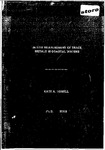IN SITU MEASUREMENT OF TRACE METALS IN COASTAL WATERS
| dc.contributor.author | Howell, Kate Ann | |
| dc.contributor.other | Faculty of Science and Engineering | en_US |
| dc.date.accessioned | 2012-08-06T15:17:56Z | |
| dc.date.available | 2012-08-06T15:17:56Z | |
| dc.date.issued | 2003 | |
| dc.identifier | Not available | en_US |
| dc.identifier.uri | http://hdl.handle.net/10026.1/1120 | |
| dc.description.abstract |
This thesis describes the use of in situ and laboratory techniques for monitoring of trace metals and master variables in the environment. Chapter 1 presents a general overview of trace metals, their sources, sinks and roles in estuaries and near coastal zones, their general characteristics and the importance of their behaviour in estuaries. Filtration and commonly used analytical methods for trace metals detemriinations in natural waters are also discussed. Chapter 2 highlights the importance of colloids (in the size range 0.2 to 0.4 \im) to membrane clogging and concludes that cojloids account for a significant part of clogging of membrane filters. The aim of this study was to extend earlier studies by examining the trends of filtrate concentrations as a function of filtration volume in riverine and estuarine waters with contrasting matrix composition, over two different seasons. Based on the findings presented in this chapter some metal specific filtration protocols are suggested. Chapter 3 provides an overview of developments in instrument automation that have led to miniaturisation and resulting in manufacture of portable electrochemical instrumentation. Such instrumentation has been used for continuous trace metal measurements from the banks of estuaries and on-board ships. The most recent developments in flow-through cells with a gelcoated Iridium (Ir) micro-electrode array have resulted in submersible in s/Yu voltammetric probes which allow long-term trace metal measurements at sub-nanomolar concentrations in coastal waters. Such In situ probes hold great promise for water quality monitoring. Chapter 4 presents the optimisation and validation of a Voltammetric In situ Profiling (VIP) system for the simultaneous determinations of Cd(ll), Cu(ll) and Pb(ll) in estuarine and coastal waters. The trace metal faction measured by the VIP system is termed 'dynamic' and includes and includes these free ions and small complexes with size smaller than a few nm. Systematic studies in NaNOa and seawater were conducted and these showed that variations in ionic strength, pH and dissolved oxygen did not affect the response of the instrument, whereas an Arrhenius type temperature response was observed. During the work, physical and voltammetric settings of the VIP system were considered and tested in detail in order to achieve the analytical requirements to perform measurements in the laboratory and during in situ deployments^ The VIP instrument has a detection limit (defined as 3cj) in seawater for Cd(II) of 23 pM, Cu(ll) 1.13 nM, and Pb(ll) 23 pM. The accuracy of the VIP system was determined with certified reference material (CRM), showing good agreement. Chapter 5 discusses the results of an international laboratory inter-comparison exercise, in order to verify precision and accuracy of measurements made by 4 laboratories that operate VIP systems located in Plymouth, U.K; Geneva, Switzeriand and Ancona, Italy, using laboratory reference methods as a comparison. Inter-comparison included analysis of Tamar Estuary samples and in situ VIP system measurements in the coastal waters of the Gullmar Fjord, Sweden. Chapter 6 presents the results of field deployment of the automated Voltammetric In situ Profiling (VIP) system for the simultaneous determinations of dynamic Cd(ll), Cu(ll) and Pb(ll) in three estuaries located in the Southwest of England, UK. The VIP instrument allowed the In situ determination of 2-4 samples h'\ In addition, the VIP system measured total filterable (0.4 pm pore size filter) concentrations of Gd(ll) and Pb(ll) in discrete estuarine water samples. Through a series of tidal surveys lasting 7-12 h each and totalling 7 surveys a high resolution data set including speciation information was built up that enabled an interpretation of geochemical processes in the studied estuaries. Chapter 7 shows the results of In situ determination of VIP dynamic metal concentrations in the Po plume arid Adriatic Sea. Concentrations were similar to those previously reported for this coastal sea system. The correlation of the metals with salinity was presented and highlighted the importance of local effluent inputs close to the river mouth for Cd(ll). The data demonstrated that the Adriatic was not heavily contaminated with trace metals. Chapter 8 presents the overall conclusions from the research and makes suggestions for future work. | en_US |
| dc.language.iso | en | en_US |
| dc.publisher | University of Plymouth | en_US |
| dc.title | IN SITU MEASUREMENT OF TRACE METALS IN COASTAL WATERS | en_US |
| dc.type | Thesis | |
| dc.identifier.doi | http://dx.doi.org/10.24382/4343 |
Files in this item
This item appears in the following Collection(s)
-
01 Research Theses Main Collection
Research Theses Main


